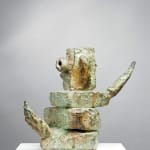


Joan Miró Spain, 1893-1983
10.04 x 14.96 x 6.69 in
Further images
However, Miró came to embrace sculpture fully by way of ceramics. As Emilio Fernández Miró tells us, “from the 1950s, visits to the Artigas studios in Gallifa, out in the country, near Barcelona, were very frequent. He liked being surrounded by the elements that were most significant to him: earth, stone, insects, clay, the magic of the wood-fired kiln and the consequent mystery of the results of the firing, since the temperature cannot be regulated as easily as with electric or gas-fired kilns”.
Those ceramic kilns were the birthplace of Miró as a sculptor; he began by modelling ceramics and casting them in bronze and ended up giving new life to the objects that populated his studio. With these objects Miró constructed new figures, which he assembled and then cast in bronze, painting over them in some cases in a wide range of colours. As the artist himself said of the new studio that Josep Lluís Sert designed for him in Palma de Mallorca, he wanted “a big studio, full of sculptures that give you a tremendous feeling of entering a new world; [...] the sculptures must resemble living monsters who live in the studio—a world apart.”
___
Joan Miró is regarded as an innovator in the Surrealist movement, rendering the subconscious and bringing it to life in an abstract style that is instantly recognisable. This concept would later inspire Abstract Expressionists in the early 20th century. Often driven by interior emotions, spontaneity and gesture inform his works, resulting in less calculated, "freer" works. Working in a limited colour palette, Miró worked across sculpture, ceramics, works on paper, and painting.
The year 1941 marked a turning point in Miró’s career. It saw his first retrospective at MoMA in New York, which decisively cemented his international prestige and influenced the generation of artists who were to create American Abstract Expressionism, including Arshile Gorky, Mark Rothko, Robert Motherwell and Jackson Pollock.
By this time, Miró had consolidated a painterly language of his own, integrating the whole picture space into a single surface in which form and content are fused. Miró started using black through his experience as a printmaker and he applied it in his work as a new form of expression. It also comes from the Chinese calligraphy Miró so much admired. Miró himself explained, “I have exercised my tendency to strip away, to simplify, in three areas: modeling, colors, and figuration of the characters”.
The artist was featured in major retrospectives that took place at MoMa in 1941, the Musée National d’Art Moderne, Paris, in 1962, and the Grand Palais, Paris, in 1974 and 2019. His work is featured in top collections around the world including the Metropolitan Museum of Art, New York, Museum of Fine Arts Boston, Art Institute of Chicago, Reina Sofia Madrid, and many more. Miró recently had a major retrospective at the Beaux-Arts Museum in Mons, Belgium.
Provenance
Exhibitions
Calder & Miró, MARUANI MERCIER, July – August 2023, Knokke, BelgiumCalder & Miró, MARUANI MERCIER Gallery, 22 July - 31 August, 2023
Joan Miró, Five Decades 1931 - 1981, MARUANI MERCIER Gallery, 1 October 2021 - 9 January 2022, Brussels, Belgium


